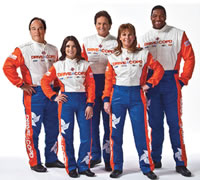Respiratory Factor
COPD on the Fast Track

The DRIVE4COPD celebrity team includes, from left, actor Jim
Belushi, NASCAR darling Danica Patrick, Olympic gold medalist
Bruce Jenner, country singer Patty Loveless and pro football great
Michael Strahan.
What do Jim Belushi, Bruce Jenner, Patty Loveless, Danica Patrick and Michael Strahan have in common? They all have close family members affected by chronic obstructive pulmonary disease. That’s why in February, these Hollywood, sports and music stars brought the public along on DRIVE4COPD, a race traveling 6,000 miles in four days to find the millions of people at risk for COPD. It’s estimated that up to 12 million people may be undiagnosed.
As a respiratory therapist or home respiratory equipment provider, you see the impact of COPD daily. Yet even though the disease is the nation’s fourth leading cause of death, it is still relatively unknown among the public when compared with cancer or heart disease.
DRIVE4COPD aimed to raise awareness. With pit stops in 14 cities crisscrossing from Detroit to Dallas and Los Angeles to Boston, the celebrities carried their message to thousands. The result was that more than 27,000 people completed the screening test to see if they were at risk and should talk to their doctors. The goal is to get 1 million people screened in the fi rst year of the campaign.
Country music star Patty Loveless wrote “Drive,” an original song for the event about living life to the fullest. Her sister died at 48 due to emphysema. Danica Patrick’s grandmother was affected by emphysema as well. “I remember how my grandma struggled to breathe and how it limited her life,” she says. “That’s why our goal is to get at least 1 million people to take a five-question screener to fi nd out if they may be at risk for COPD and should talk to their doctor. Because the sooner you act, the sooner you can get on the road to breathing better.”
The American Lung Association, Boehringer Ingelheim Pharmaceuticals Inc., COPD Foundation and NASCAR are sponsoring this multiyear public health initiative to highlight the need for early detection of COPD. “Most people believe their symptoms, such as shortness of breath, are just normal signs of aging so they are not diagnosed until they have already lost half of their lung function,” says Charles Connor, American Lung Association president and CEO. “It is important to recognize symptoms and see a doctor early.”
The race started Feb. 13 in front of packed stands at the historic Daytona International Speedway and ended Feb. 16. Following the celebrity four-day kickoff, the campaign continues with COPD screening events at NASCAR races, major sporting events and country music concerts. The DRIVE4COPD celebrity ambassadors will continue spreading their message through public service announcements and briefi ngs on Capitol Hill this year.
The brief, five-question screener was designed by a clinical working group of 10 pulmonologists and primary care physicians. A national survey of nearly 700 patients at 12 practitioner sites found five items that positively predicted airflow obstruction: breathlessness, productive cough, activity limitation, smoking history and age. These five items became the COPD Population Screener. A study validating this screener was published in April 2008 in COPD: Journal of Chronic Obstructive Pulmonary Disease.
COPD Facts
- Approximately 24 million Americans have some form of COPD.
- Half of those with COPD, or 12 million, don’t know they have it.
- Even when people are diagnosed with COPD, only half of them are prescribed treatment.
- COPD is the fourth leading cause of death in the United States, taking one life every four minutes.
- COPD is the only leading cause of death that is increasing in prevalence.
- COPD kills more people each year than breast cancer and diabetes combined.
- COPD accounts for more than $40 billion in total health care costs.
- Women are at increasingly high risk for COPD, as the death rate is growing faster among women with COPD than men.
- The emotional trauma of COPD can be debilitating, and many COPD patients can feel depressed because they have to change their lifestyle.
This article originally appeared in the Respiratory & Sleep Management April 2010 issue of HME Business.